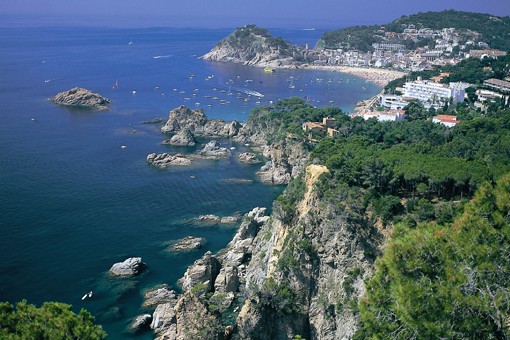 Costa Brava holidaymakers relax at wide, sandy beach resorts, or head inland to follow a trail of art, architecture and history. Book a Costa Brava hotel on the seafront or tucked away in a quiet mountain village.
Costa Brava holidaymakers relax at wide, sandy beach resorts, or head inland to follow a trail of art, architecture and history. Book a Costa Brava hotel on the seafront or tucked away in a quiet mountain village.The Costa Brava borders the Pyrenees mountains to the north and the Mediterranean Sea to the east. Its coastline extends from French border village Portbou past the Cap de Creus Natural Park whose arid, rocky cliffs lead down to the waterfront. Southwards the coast shifts between long, sandy bays dotted with resorts to the wetlands of l’Empordà Natural Park and craggy coves. Inland, the motorway passes Figueres and Girona, the Costa Brava’s main cities. To the west lies Banyoles’ natural lake and the volcanic area of the Garrotxa Natural Park.
There’s a varied coastline to enjoy on Costa Brava holidays. In the north are Cadaqués’ golden sands. Scuba divers come to Cap de Creus beaches like Jóncols Cove near Roses to see the red corals offshore. The Aquabrava water park nearby has the biggest wave pool in Europe. You can find a tranquil beach in the bays of Begur and Palafrugell. Other visitors prefer Costa Brava hotels in Lloret de Mar or Tossa de Mar, lively family seaside towns with restaurants on the promenade and watersports on the beach.
Costa Brava’s cuisine is seafood-rich with delicious suquet fish stew and black fishy rice on many menus. Meat dishes include trinxat, a pork, garlic, potato and cabbage dish, while doughnut-style sugary fritters are a favourite with sweet lovers. One of the best places to try local cuisine is at food festivals, dedicated to almost every ingredient as well as regional wines.
For a relaxing break, Girona’s therapeutic hot springs provide the perfect treat. Choose thermal baths in Caldes de Malavella or a spa in Pyrenean Llanars. For a sedate pace, explore Blanes’s prized Marimurtra botanical garden, or take a boat trip across Banyoles Lake, its clear waters reflecting the countryside. Others prefer to relax with a few rounds at Club Golf d’Aro in the mountains.
Throughout the Costa Brava are reminders of the past. Girona’s mixed heritage includes a Romanesque monastery, baroque cathedral, Jewish quarter and Arabic baths, all within its old town. Figueres’ La Rambla has a range of architectural styles including the Catalan modernista seen throughout the region. You’ll learn about the Palaeolithic, Greek and Roman past at Roses’ Citadel, while Sant Pere de Rodes is a striking former Benedictine monastery in the mountains.
Art lovers can admire Salvador Dalí’s Surrealist art works at the Dalí Theatre-Museum in Figueres and personal effects in the Dalí House-Museum. Visitors can also go inside Púbol Castle, bought for his wife. In Llagostera, the Emili Vilà House-Museum is named after a former poster artist whose works are on display here along with an impressive collection of small-scale work by Modigliani and Toulouse-Lautrec.